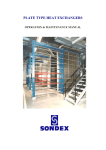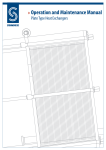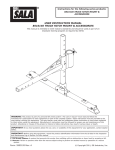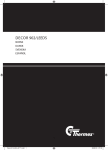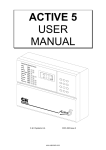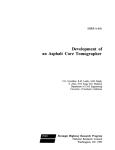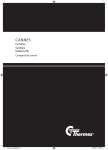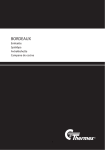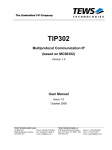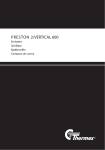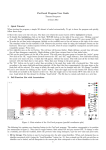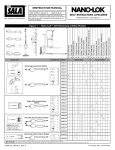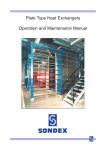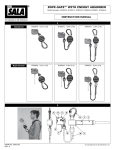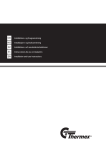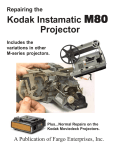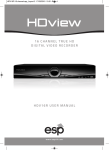Download Gasketed Plate Heat Exchangers Installation & Operation Manual
Transcript
TTS005 – Gasketed Plate Heat Exchangers Installation, Operation & Maintenance Manual thermex Ltd Gasketed Plate Type Heat Exchangers Installation, Operation and Maintenance Manual thermex Ltd Merse Road, North Moons Moat, Redditch, Worcestershire. B98 9HL. United Kingdom T +44(0)1527 62210 F +44(0)1527 60138 E [email protected] W www.thermex.co.uk Revision Date: December 2010 Page 1 of 23 TTS005 – Gasketed Plate Heat Exchangers Installation, Operation & Maintenance Manual thermex Ltd Contents 1. 2. 3. 4. FOREWORD INTRODUCTION SAFETY ALERT NOTICES GENERAL 4.1. Identification of the heat exchanger 4.2. Correct operation 4.3. Cautions 4.4. Thermal design 5. CONSTRUCTION 5.1. Frame 5.2. Plates 5.3. Gaskets 5.4. Special executions 5.5. Right / left plates 6. INSTALLATION 6.1. Requirements of the installation area 6.2. Transport, lifting & storage 6.3. Installing the pipe connections 7. COMMISSIONING & OPERATION 7.1. Commissioning & pre-checks 7.2. Operation 7.3. Shut-down for short periods 7.4. Shut-down for long periods 8. MAINTENANCE 8.1. Clean in place (CIP) 8.2. Cleaning Detergents 8.3. Opening the heat exchanger 8.4. Cleaning the plates 8.5. Plate replacement 8.6. Gasket replacement 8.7. Tightening & testing of the plate pack 8.8. Maintenance of the heat exchanger 9. PROBLEM SOLVING 10. AFTER SALES SERVICE 10.1. Ordering parts 10.2. Modifications to the heat exchanger 10.3. Contacts 3 3 3 4 4 4 5 6 7 7 7 7 8 8 10 10 10 12 13 13 13 14 14 15 15 15 16 17 18 18 19 20 21 23 23 23 23 Revision Date: December 2010 Page 2 of 23 TTS005 – Gasketed Plate Heat Exchangers Installation, Operation & Maintenance Manual thermex Ltd 1 FOREWORD This manual is a guide for installation, commissioning and maintenance of plate type heat exchangers supplied by Thermex. It is meant for those who are responsible for the installation, the use and maintenance of thsee heat exchangers. We recommend that you read this manual carefully before commencing any work. 2 INTRODUCTION This manual is applicable for all bolt-up plate type heat exchangers produced and supplied by Thermex. Thermex can not be held responsible or liable for damage as a result of incorrect installation, use and / or maintenance of Thermex plate type heat exchangers, or arising from non-compliance with the instructions in this manual. Please note that our plate type heat exchangers are specially designed and built for the operating conditions (pressures, temperatures, capacities and type of fluids) provided by the customer. Sudden pressure peaks beyond the normal operating pressure (or pressure surges) which can occur during starting up or stopping of the system can severely damage the heat exchanger and should be prevented. Thermex can not be held responsible for any damage as a result of any operation deviating from the original design conditions. If you wish to alter the design conditions, please contact us: refer to page 23 for contact details. You may only commission the heat exchanger under the modified conditions after inspection and written approval by Thermex. Also the name plate on the heat exchanger will be adapted, modified or replaced. 3 SAFETY ALERT NOTICES The following must be respected when installing, running or servicing Thermex plate heat exchangers: Observe current local safety regulations. Ensure that the exchanger is depressurised and cooled to below 40ºC. Use gloves to prevent any injury from sharp edges when handling plates. In all cases ensure that all local health and safety and environmental protection laws and regulations are strictly adhered to when working. YELLOW TRIANGLE Refer to applicable SAFETY ALERT notices within the manual! All SAFETY ALERT notices are applicable to personal injury and identified by this symbol. Revision Date: December 2010 Page 3 of 23 TTS005 – Gasketed Plate Heat Exchangers Installation, Operation & Maintenance Manual thermex Ltd 4 GENERAL 4.1 Identification of the heat exchanger All plate type heat exchangers supplied by Thermex are provided with a name plate. On this plate the following details are specified: • type of heat exchanger • year of manufacture • manufacturing number • nominal capacity in kW 2 • • • • • transmission area in m max. working pressure in bar test pressure in bar max. working temperature in °C min. assembling measure in mm 4.2 Correct operation This user manual provides information and instructions for correct and safe operation of the unit. Many accidents are caused by incorrect use! It is essential that you study the instructions carefully, and above all ensure it’s availability to those who install, maintain and operate the heat exchanger on a daily basis. This manual is of no value if it is not available at the time when your staff need it. If a problem occurs with your Thermex Heat Exchanger which is beyond the scope of Revision Date: December 2010 Page 4 of 23 TTS005 – Gasketed Plate Heat Exchangers Installation, Operation & Maintenance Manual thermex Ltd this manual, do not hesitate to contact us. The installation should not be put into operation before all queries have been answered! To avoid injury and damage, follow the instructions and local applicable health and safety regulations. Also take the necessary protective measures, depending on the nature of your process or circumstances related to it, at your plant. Please note that our plate type heat exchangers are especially designed and built for the operating conditions (pressures, temperatures, capacities and type of fluids) provided by the customer. Sudden pressure peaks beyond the normal operating pressure (or pressure surges) which can occur during starting up or stopping of the system can severely damage the heat exchanger and should be prevented. Thermex can not be held responsible for any damage which occurs as a result of any operation deviating from the original design conditions. If you wish to alter the design conditions, please contact us. You may only commission the heat exchanger under the modified conditions after inspection and written approval by Thermex. Also the name plate on the heat exchanger will be adapted, modified or replaced. 4.3 Precautions All potential personal injury hazards are identified by safety alert symbol. Bodily harm can be caused by: • burning as a result of touching the heat exchanger or other parts of the installation; • the uncontrolled release of pressurised media with which the danger of burning and other injuries is present; • contact with chemicals; • touching sharp edges of the installation. Damage to equipment can be caused by: • external forces; • corrosion; • chemical action; • erosion; • material exhaustion; • water hammer; • thermal and / or mechanical shock • freezing; • wrong transport / lifting. Even after stopping the installation some parts of it can still be hot! The heat exchanger may only be used with the fluids specified on the datasheet. The hot medium may not flow through the exchanger without the cold medium flowing through. This is to prevent damage to the exchanger. In case the cold medium is present but does not flow while the hot medium is flowing through, the cold medium will start boiling and the exchanger will be damaged. Sudden pressure and temperature changes should be prevented. Revision Date: December 2010 Page 5 of 23 TTS005 – Gasketed Plate Heat Exchangers Installation, Operation & Maintenance Manual thermex Ltd When a heat exchanger (filled with water or a water mixture) which is not in operation is exposed to temperatures below zero, the plates can become deformed. If a danger of frost occurs, the heat exchanger should be drained completely. Demountable plate heat exchangers can always leak. We advise you to take this into account while installing. Preferably you should install a drip tray underneath the heat exchanger to prevent leakages onto the floor and/or harm to electrical equipment. (Short circuit/moisture damage). If the heat exchanger is being used with temperatures above 60º C or with aggressive fluids, we advise you cover the heat exchanger with a screen plate to prevent the risk of touching. If welding activities have to be carried out near the heat exchanger, never use the heat exchanger for earthing the construction work. Electrical currents can cause severe damage to both plate and gasket. If you have to carry out a welding operation on the system which includes the heat exchanger, dismantle the connecting flanges and isolate the heat exchanger from the system before starting welding work. 4.4 Thermal Design Thermex plate type heat exchangers are designed and calculated according to the newest technology. If a performance test has to be carried out on the unit, the exchanger must be totally clean before the test. In the Thermex data sheet the nominal capacity and pressure losses are mentioned. The pressure loss can deviate by up to 15 % from the data in the data sheet depending on plate thickness, the plate material and the difference in the two working pressures. Revision Date: December 2010 Page 6 of 23 TTS005 – Thermex Plate Heat Exchangers Installation, Operation & Maintenance Manual 5 CONSTRUCTION 5.1 Frame The heat exchanger consists of a frame plate (head), a pressure plate (follower), a carrying bar, a lower bar and a column. Tie (clamping) bolts are used to press the plate package together. The size and number is depending on the type of heat exchanger. 5.2 Plates The plate package consists of plates with a groove along the rim of the plate and around the ports. The number of plates, their size and design, is dependant on the thermal output required. Depending on the application stainless steel or titanium plates might be used 5.3 Gaskets The groove provided in the plates holds the special gasket. The purpose of this gasket is to prevent intermixing of the media and leakage to the outside. The gaskets are selected to suit the actual combination of temperature, chemical resistance and possible other conditions to be considered. They can be supplied in Viton, Nitrile or EPDM. Page 7 of 23 TTS005 – Thermex Plate Heat Exchangers Installation, Operation & Maintenance Manual The following types of gaskets are used in our plate type heat exchangers: • Glue gaskets • "Snap-in" gaskets • "Lock-on" gaskets (new generation of gaskets) • "Hang-on" gaskets “Snap-in” gasket “Lock” gasket “Hang On” gasket 5.4 Special applications If the plate heat exchanger works with several fluids at the same time, it may be necessary to insert intermediate frames. The intermediate frames are equipped with corner blocks which form the connections between the different sections. Two connections can be placed in the same corner block with a connection to two different sections in the plate heat exchanger. For the exact application of your plate type heat exchanger please check the documentation which was supplied with the heat exchanger. 5.5 Right/left plates The heat exchanger plates are designed in such a way that they can be used both as right and as left plates. The plates just have to be turned 180º. ( Excepted are types S1, S53 and SF52, which are “diagonal” plates. Here right and left plates are different ). Right and left plates: • On a right plate the flow runs from hole 2 to hole 3 or reverse from hole 3 to hole 2. • On a left plate the flow runs from hole 1 to hole 4 or reverse from hole 4 to hole 1. Page 8 of 23 TTS005 – Thermex Plate Heat Exchangers Installation, Operation & Maintenance Manual The opening of the corner holes are described in a “plate code index”. For instance 1234 means that all corner holes are open. Every plate can be identified by the gasket configuration, the plate code index and thermal short or thermal long execution. Plate Types Start plate with gasket Left hand flow plate with gasket Right hand flow plate with gasket Thermal long plate Thermal short plate Page 9 of 23 TTS005 – Thermex Plate Heat Exchangers Installation, Operation & Maintenance Manual 6 INSTALLATION 6.1 Requirements in the installation area It is very important that enough space is kept free around the heat exchanger for servicing of the unit, including renewing plates & gaskets and tightening of the plate package. As a rule of thumb the free space around the unit should be 1.5 to 2x the width of the unit. 6.2 Transport lifting and storage. WARNING: To prevent personal injury always use appropriate hoisting equipment. If you are lifting the heat exchanger itself, straps should be used. They should be placed as shown in the picture at left. Page 10 of 23 TTS005 – Thermex Plate Heat Exchangers Installation, Operation & Maintenance Manual Lifting: Usually the heat exchanger will be supplied lying horizontal on a pallet. The back side of the head will then be strapped to the pallet. This allows you to transport the unit easily by means of a forklift truck. Lifting of the unit: • Remove all straps from the pallet. • Place straps around one bolt on each side as shown in the picture. NEVER use steel cables or chains! • Lift the heat exchanger from the pallet. • Lower the heat exchanger slowly to the vertical and onto it’s feet, locating it in it’s installation position. • Remove the lifting straps and secure the heat exchanger to the floor NEVER lift the heat exchanger using the connectors or the studs around them. Attention: ALWAYS: • Use the lifting eyes if fitted. • Lift the top side of the head. • Attached the straps to the bolts close to the head. NEVER: • Lift using the connections. • Lift with the follower plate. • Lift using an intermediate plate. • Lift with a strap attached close to the follower. Storage: Should it be necessary to store the heat exchanger for a longer period (1 month or more), certain precautions should be taken in order to prevent unnecessary damage to the equipment. Preferably the heat exchanger should be stored inside in a room with a temperature around 15 to 20 ºC and a humidity of max. 70%. If this is not possible, place the heat exchanger in a wooden box which is provided with a lining on the inside against penetration of moisture. It is not permissible to install the heat exchanger in a room containing ozone producing equipment, including electric motors or arc-welding equipment, since ozone destroys many rubber materials. Also do not store organic solvents or acids in the room and avoid heat or ultraviolet radiation. Page 11 of 23 TTS005 – Thermex Plate Heat Exchangers Installation, Operation & Maintenance Manual 6.3 Installing the pipe connections Depending on the type, the Thermex plate type heat exchanger will be provided with flanges, couplings, threaded pipes, etc. When connecting the pipe system to the heat exchanger make sure that no stress or strain is imposed, by the pipe system, on to the heat exchanger! We advise you of the following: • Heavy pipe work needs to be supported. This will prevent excessive loading on the heat exchanger. • Always install flexible connections on the follower to prevent vibrations on the heat exchanger. o Flexible connections also prevent expansion of the pipe work, caused by temperature influence, onto the heat exchanger. o Flexible connections need to be fitted in a longitudinal direction to the plate package. • The pipe work needs to be thoroughly cleaned and flushed before connecting up to the heat exchanger. • Always install vents on both sides of the heat exchanger. Note: For proper venting the vents should be fitted on the highest point in the direction of the flow of the medium (preferably on an air vessel). To enable the heat exchanger to be opened when necessary shut off valves should be provided in all connections! Make sure that the pipe work connected to the heat exchanger is protected against pressure peaks / surges and temperature shocks! Threaded pipe connections: If a plate type heat exchanger is provided with threaded pipe connections, make sure that these connections do not rotate when fitting to the pipe work. During installation the threaded pipe on the heat exchanger should be supported to prevent it rotating otherwise damage to the gasket on the start plate may occur. Flange connections: If the connection is rubber lined, the liner will act as the flange gasket. Bolt the connecting flange directly to the endplate using the drilled and tapped holes provided. Tighten the bolts evenly – do not over-tighten as this could strip the threads cut into the frame plate. If loose backing flanges are fitted to the heat exchanger a suitable gasket is required to seal the flange. Unless otherwise stated, the liquid circuits should be connected to flow in reverse directions through the exchanger (counter-current). Refer to the contract drawing or quotation details if the connections are not marked. Page 12 of 23 TTS005 – Thermex Plate Heat Exchangers Installation, Operation & Maintenance Manual 7 COMMISSIONING 7.1 Commissioning and pre-checks Commissioning may only be done by staff specially trained for the job or by Thermex approved commissioning engineers. Control, maintenance and repair of the installation may only be done by authorized, trained and properly instructed staff. Maintenance and cleaning may only be done with a heat exchanger cooled to under O 40 C and shut down! Check and ensure that all connections are fitted correctly and to the correct ports (see also 6.3). Filtration: The media flowing through the heat exchanger should not contain particles larger than 0,5 mm diameter/length. If necessary an inline filters should be fitted. Check the pressures and temperatures of the media and make sure that these are not more than the values specified on the name plate. It is essential that the heat exchanger is not subjected to thermal or mechanical shock as this could lead to premature gasket failure 7.2 Operation Start cold circuit first, then the hot circuit. • • • • • • Fully vent the system; Close shut off valve fitted between pump and exchanger; Fully open valve fitted into return line from the exchanger; Start the circulation pump normally placed by the inlet; Gradually open closed shut off valve between pump and exchanger; Vent system again if necessary. Repeat the above for the secondary circuit. When using steam as one of the media: Use slow acting steam control valves and open slowly shut off valves! Before start up: • Ensure that the steam control valve is fully closed; • Ensure that the heat exchanger is fully drained of condensate ; • Start cold circuit first, then the steam side; • Open steam control valve slowly – this prevents water hammer of any condensate in the steam line and reduces the pressure / thermal shock to the exchanger; • Ensure that the steam trap is correctly sized to allow full condensate discharge – this prevents water clogging inside the exchanger. Page 13 of 23 TTS005 – Thermex Plate Heat Exchangers Installation, Operation & Maintenance Manual Check for proper operation: • Check for pressure pulses in the system caused by the pumps or control valves. If found, stop operation and rectify. Continuous pressure pulses will result in fatigue failure of the plates. Visually check the unit for leakages. Check that all vents are closed to prevent air being sucked into the system. When in operation, the conditions should not be changed. The maximum conditions specified on the name plate should not be exceeded. 7.3 Shut-down for a short period If the plate type heat exchanger has to be shut down for a short period, please follow the following procedure: • Slowly close the control valve in the hot circuit whilst maintaining the full flow in the cold circuit; • Switch off the hot circuit pump; O • • • • Cool down the heat exchanger to under 40 C; Slowly close the control valve in the cold circuit; Switch off the cold circuit pump; Close all remaining shut off valves. 7.4 Shut-down for a long period If the unit is to be taken off line for an extended period of time then the following procedure should be followed: Point 7.3 must be followed, then: • Allow unit to cool down; • Drain all circuits; • Lubricate threads on the tie (clamping) bolts; • Loosen tie clamping bolts until the plate pack is “loosened” (max. "A" size + 10%). • The tie bolts should not be removed or loosened to such an extent that dirt is allowed to enter in-between the plates. We recommend that a warning notice is attached to the exchanger to remind personnel that the tie clamping bolts need adjustment before the unit can be put back into service. • Cover the plate pack with black plastic to exclude any sunlight. Please also see chapter 6.2 – Storage Page 14 of 23 TTS005 – Thermex Plate Heat Exchangers Installation, Operation & Maintenance Manual 8 MAINTENANCE 8.1 CIP cleaning (clean in place by circulating cleaning detergents) To use CIP cleaning, it is a condition that the scaling on the plates is soluble. All materials in the whole circulation system of course have to be resistant to the cleaning detergent. We advise you to ask for a confirmation from the supplier of the cleaning detergent that it will not damage the materials in the heat exchanger. If the solution requires recirculation, select a flow that is as high as possible, and certainly no less than the service or product flows. Follow the instructions as given by the detergent supplier / cleaning specialist. We suggest that for recirculated cleaning detergent methods, the fluid should be pumped through the exchanger for no less than 30 minutes. Rinsing After using any type of cleaning agent, always rinse thoroughly with fresh water. If cleaning in place then circulate fresh water for at least 10 minutes. 8.2 Some Cleaning Detergents Oil and grease can be removed with a water emulsifying oil solvent i.e. BP system. Organic and grease cover can be removed with sodium hydroxide (NaOH) maximum concentration 1,5% - max. temp. 85 ºC. Mixture for 1,5% concentration = 5 ltr. 0% NaOH per 100 ltr. water. Stone and limestone can be removed with nitric acid (HNO3) - max. concentration 1,5 % - max. temp. 65 ºC. Mixture for 1,5% concentration = 2.4 ltr. HNO3 62% per 100 ltr. water. Nitric acid also has an affective build up effect on the passivation film of stainless steel! CAUTION: Nitric acid and Sodium Hydroxide may cause injury to exposed skin, eyes, and mucous membranes. Use of protective eyewear and gloves is strongly recommended. Page 15 of 23 TTS005 – Thermex Plate Heat Exchangers Installation, Operation & Maintenance Manual 8.3 Opening the plate heat exchanger When • • • • • • • opening and assembling the heat exchanger observe the following: Measure and note the actual "A" size; Use the correct tools and lubricant; Shut down the heat exchanger as described under 7.3; Make sure the heat exchanger cools down (<40 ºC); Ensure there is no pressure on any part of the unit; Clean the tie (clamping) bolts and grease the threads; Loosen the tie clamping bolts equally in the correct order (fig. 10) i.e. that the follower shall have a parallel opening motion; • Pull the follower back towards the column; • Remove the plates without damaging the gaskets. CAUTION: Ensure unit is depressurized and drained of hot and/or aggressive product before unit is opened to prevent personal injury. CAUTION: Sharp edges. When handling plates, gloves should be worn. Recommendation: Mark the plate package before opening. You could mark the plate package with a diagonal line on the outside fig 10a, or number the plates in sequence. Page 16 of 23 TTS005 – Thermex Plate Heat Exchangers Installation, Operation & Maintenance Manual 8.4 Cleaning the plates CAUTION: Always wear gloves cleaning detergents. and eye goggles when using Use nylon or other types of “soft” scrubbing brushes with detergent. Never use a metal brush, steel wool or sand/glass paper. This will damage the passivation film of the plates. Use Acetone or other types of solvents which do not contain chlorine to remove old gasket glue. Alternatively use a ”lowtemp” gas flame softly heating the reverse side of the plate. Do not use any other type of gas which may produce a “harder” flame. Remember ventilation. Boiling water can be used with some success. Consult a cleaning specialist for a suitable choice of detergent. Ensure that all detergents used are compatible with the plate and gasket material before use. In case plates are removed for manual cleaning, make sure they are re-fitted in the same order. Always remove plates one by one and number them! A high pressure cleaner can be used but with absolute care and never add abrasives. If the scaling or organic layer is thick the plates can be put in a barrel with qualified cleaning material. Before fitting chemical cleaned plates they need to be thoroughly rinsed with fresh water! Important: Cleaning is an important part, influencing the effectiveness of the plate heat exchanger. Insufficient cleaning can have the following results: • • • too low circulation flow; insufficient thermal output; life time of the heat exchanger will be shortened. If a plate has to be renewed because of serious damage, the plates next to this plate normally need to be replaced. Page 17 of 23 TTS005 – Thermex Plate Heat Exchangers Installation, Operation & Maintenance Manual 8.5 Plate replacement The plates must be clean, dry and free from oil or grease. If there are any oil remains on the gaskets, or on the gasket seating area, then there is a high risk that the plates or gaskets shall slip out of place when the unit is being tightened. If the gaskets are contaminated with dirt or grit, then these could cause leakage. • make sure that all seating areas are flat, clean and undamaged. • always use new gaskets. Fit the plates according to the Plate Sequence Sheet – ensure all gaskets face towards the fixed frame plate (head). Alternate between left and right handed plates – if the plate edges form a regular honeycomb pattern, the left / right hand sequence is correct, see fig.11. 8.6. Gasket replacement Glue free gaskets This type of gasket (“Hang-on”) and “Lock” (new generation of glue free gasket) require no adhesive. They are located by pushing the gasket fully down into the gasket groove or fastened by special devices. Make sure groove and gasket are clean! Glue type gaskets The surfaces need to be clean and free of oil. Only use chloride free glues like Pliobond 20 or 30, Bostic 1782, 3M EC 1099 and Bond Spray 77. Follow the instructions of the manufacturer; these will be printed on the cover of the glue. CAUTION: When using commercial solvents and adhesives, follow the manufacturers recommendations carefully, as many of these materials are hazardous. Page 18 of 23 TTS005 – Thermex Plate Heat Exchangers Installation, Operation & Maintenance Manual Ring Gaskets The ring gaskets are used in connection with intermediate frames, by connections in the follower and by ”SW” (Semi Welded) types. It can be necessary to use a little glue for positioning the ring gasket during assembly of the heat exchanger. Rubber Liners There is one type of rubber liners for connections in the head an another type of rubber liners for connections in the follower. 8.7 Tightening and testing of the plate pack • • • • • Lightly oil the tie (clamping) bolt threads. Do not allow oil or grease onto the gaskets or the gasket seating faces on the back of the plates. Wet or contaminated plates can be-come misaligned during tightening. In this case, dismantle, clean, and dry all areas in contact with the gaskets. Evenly tighten all bolts in the correct order (refer page 17 fig. 10). We advise the use of ratchet spanners. Ensure clamping is as uniform as possible, thus keeping the frames and plates parallel throughout the operation. Avoid skewing the frame plates by more than 5 mm. Tightening is complete when the distance between the inside faces of both frame plates equals the “A” distance as shown on the contract drawing, see fig. 12. This tightening distance can also be calculated using the following formula: Assembly distance = No. of plates x (plate thickness + coefficient) o The coefficients can vary depending on the model type, but is often 0,1 mm. Finally check that all tie (clamping) bolts are in tension and clean any spilt oil off the head, follower and plates. On completion the unit can be pressure tested (test pressure is stated on the name plate). Page 19 of 23 TTS005 – Thermex Plate Heat Exchangers Installation, Operation & Maintenance Manual If dimension "A" is not reached with application of maximum tightening torque: • check the number of plates and dimension A on the data sheet; • check that all the nuts and bearing boxes are running freely. If not, clean and lubricate or replace. If the unit does not fully seal, it may be tightened step by step to give dimension “A” min. This dimension is mentioned on the name plate, see fig. 1. However, the minimum measure must not be exceeded. Under no circumstances distance “A” may be smaller than “A” min. Tightening of the plate package can only be done with a fully depressurized unit. 8.8 Maintenance of the heat exchanger Time interval – once a year as a minimum • • • • • Check temperatures and flows against commissioning data. Check general condition and look for any signs of leakage. Wipe clean all painted parts and check surfaces for signs of damage – “touch up” if necessary. Check bolts and bars for rust and clean. Lightly coat threaded parts with molybdenum grease or a corrosion inhibitor (ensure that no grease, etc. falls onto the plate gaskets. If rollers are fitted to the follower, lubricate the bearings with light machine oil. Page 20 of 23 TTS005 – Thermex Plate Heat Exchangers Installation, Operation & Maintenance Manual 9 PROBLEM SOLVING If you have problems with your plate type heat exchanger, in most cases these can be solved by your own personnel. Please find below a summary of possible problems as well as possible causes and solutions. A condition for the continuous proper functioning of your plate type heat exchanger is in strict compliance with the permissible values for pressure and temperature mentioned on the name plate. Exceeding these values, even as short-lasting pressure peaks will cause damage to the unit and be the cause of problems. To avoid costly repairs, we advise you to have the installation work and maintenance carried out by properly trained personnel. You can also contact relevant Thermex Sales Office. Problem Leakage Possible cause At the connections Mixing of primary & secondary circuit fluids In the plate package Operating conditions deviate from specification Insufficient capacity Air in the system Operating conditions deviate from specification Too high pressure drop The heat exchanger is dirty The connections have been interchanged Flow exceeds the design specification Channels in plate(s) blocked Incorrect measurement Medium deviating from the design Air in the system Possible solution Check the rubber liners (if fitted) Check the flange gaskets (if fitted) Check the O-ring – fit the pipes tension free Check the plates for holes and/or cracks Check the assembly distance ‘A’ Check the condition of the gaskets Check the positioning of the gaskets is correct Adjust operating conditions to within the specification of the heat exchanger De-aerate the pipe system Check the pipework for possible air traps Adjust operating conditions to within the specification of the heat exchanger Clean the heat exchanger Check and redo the pipework if necessary Adjust the flow Flush and/or clean the exchanger Check the pressure gauge operation Addition of (for instance) anti-freeze will increase the pressure drop De-aerate the pipe system Check the pipework for possible air traps Page 21 of 23 TTS005 – Thermex Plate Heat Exchangers Installation, Operation & Maintenance Manual For nearly all leakage problems it will be necessary to dismantle the unit before any attempts to rectify the fault can be made. Mark the area(s) where the leakage seems to be with a felt tip marker or similar before taking apart the exchanger. “Cold leakage” is caused by a sudden change in temperature. The sealing properties of certain elastomers are temporarily reduced when the temperature changes suddenly. No action is required as the gaskets should re-seal after the temperature has stabilised. Gasket failures are generally a result of: • • • • • • • old age excessive exposure to ozone high operating temperature – above the temp. limit of the material exposure to pressure surges chemical attack physical damage, resulting from incorrect assembly work, or damage resulting from a misaligned plate (check the hanging system at the top of the plate for distortion). Decrease in performance is generally a result of: • • • • • • • • • • • • plate surfaces require cleaning or de-scaling pumps or associated controls have failed plate channels blocked liquid flows not as per design specification associated chiller / cooling tower / boiler under sized or dirty cooling water temperature to the exchanger is higher than the design heating media temperature to the exchanger is lower than the design steam flow not sufficient – control valve malfunction steam trap broken or jammed – unit becomes filled with condensate plate package has been assembled incorrectly unit is running in co-current flow, instead of counter current – check with contract drawing and alter pipe work if necessary. Check direction of pump flows. an air lock has developing in the plate package or pipe work. Page 22 of 23 TTS005 – Thermex Plate Heat Exchangers Installation, Operation & Maintenance Manual 10 AFTER SALES SERVICE 10.1 Ordering parts When ordering parts it is important that the correct details are given. At least the following should be quoted: • Project and order number • Exchanger type and manufacturing number (see name plate) • Required parts When ordering separate plates it is important that the correct plate code index and type of plate is given. See chapter 5.2 When ordering separate gaskets it is important to indicate the correct gasket material. When ordering tie (clamping) bolts, the existing ones should be measured in order to get new ones of the same size and length. 10.2 Modifications to the heat exchanger The plate heat exchanger is built up in modules and therefore flexible with respect to enlargements or reductions. It is easy to change the capacity by respectively enlarging or reducing the number of plates. We would be pleased to advise you. 10.3 Contacts You can contact the factory as follows: thermex Ltd Merse Road, North Moons Moat, Redditch, Worcestershire. B98 9HL United Kingdom Telephone Fax E-mail +44(0)1527 62210 +44(0)1527 60138 [email protected] International customers can also locate a local distributor via our website at www.thermex.co.uk Page 23 of 23

























